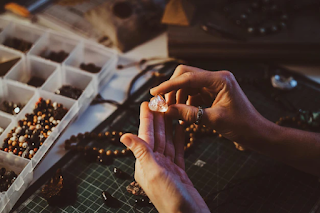What kind of metals are used to make artificial jewelry
Unlocking the Secret Ingredients: A Guide to the Metals Used in Creating Artificial Jewelry
Introduction:
Metal jewellery is timeless and always in style. From classic gold and silver to trendy rose gold and copper, metal jewellery comes in an array of styles, shapes, and finishes. But not all metal jewellery is created equal. If you're someone who loves to accessorize but prefers artificial jewellery, it's important to know what kind of metals are used to make it. In this blog post, we'll explore the types of metals used to make artificial jewellery, so you can make informed decisions the next time you're shopping for a new piece. When it comes to the raw material for making jewellery, the type of metal selected has a major role to play in its durability, look, and value. Generally, the metal used in artificial jewellery is a blend of several metals, each one adding its unique quality to the end product.
Here are some of the metals
commonly used in the making of artificial jewellery:
Jewellery making material list are as follows
1. Copper: Copper is a stunning metal that's often used in fashion jewellery. It has a warm, reddish-brown tone that complements all skin tones, and it has anti-inflammatory properties that can help relieve joint pain. Copper jewellery is affordable, lightweight, and easy to care for, which makes it a great choice for everyday wear.
2. Stainless Steel: Stainless
steel is a durable and long-lasting metal that is perfect for artificial jewellery. It's
corrosion-resistant, hypoallergenic, and it's resistant to scratches and
tarnishing. Stainless steel jewellery is often used in men's jewellery, but
it's becoming increasingly popular for women's jewellery as well.
3. Silver-Plated: Silver-plated jewellery is made by coating a base metal with a thin layer of sterling silver. It's an affordable alternative to pure silver, and it looks just as stunning. Silver-plated jewellery is lightweight, easy to clean, and it has a lustrous silver finish that complements any outfit.
4. Gold-Plated: Gold-plated jewellery is similar to silver-plated jewellery; except it's coated in a thin layer of gold instead of silver. It's an affordable alternative to pure gold, and it has a luxurious look that's perfect for special occasions. Gold-plated jewellery comes in a variety of shades, including yellow gold, rose gold, and white gold.
5. Brass: Brass is a popular metal used in artificial jewellery. It is an alloy of copper and zinc, and it has a warm-gold tone that complements all skin tones. Brass jewellery is affordable, lightweight, and easy to clean, which makes it a popular choice for everyday wear.
6. Zinc: Zinc is a metal that is often used in the making of costume jewellery due to its affordability and versatile nature. It is commonly used to create intricate designs, as it is a soft and malleable metal that can be easily moulded into different shapes.
Conclusion
In conclusion, the metal used in artificial jewellery plays a
significant role in the final product's durability, beauty, and value. The
choice of metal depends on the desired effect, the type of jewellery being
made, and the manufacturing process. Through careful selection of metals and
wise crafting, artificial jewellery can be among the most valuable, stylish,
and lasting accessories you can have. It is a great way to accessorize without
breaking the bank. With so many metals to choose from, there's surely a style
that will fit your unique taste and preferences. Knowing what kind of metals
are used to make artificial jewellery will help you make informed buying
decisions and ensure that you're getting a quality piece that will last you for
years to come.







Comments
Post a Comment